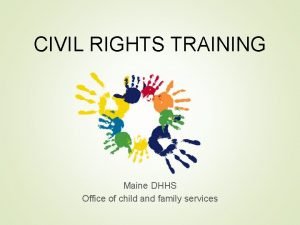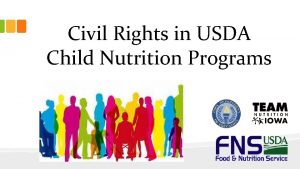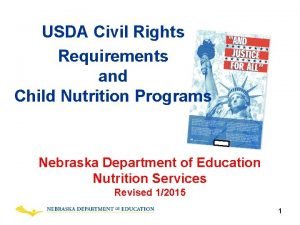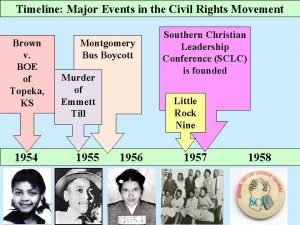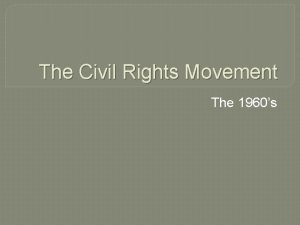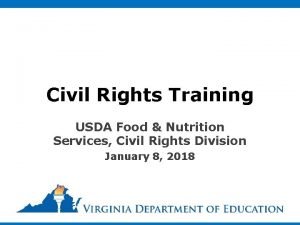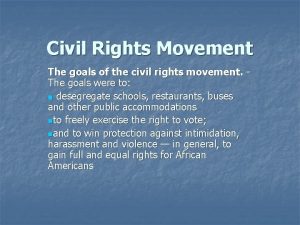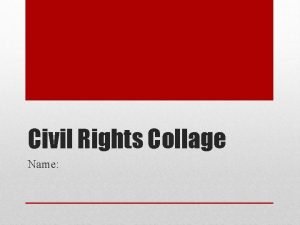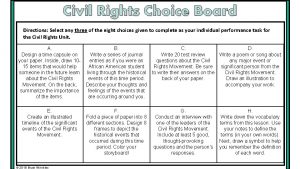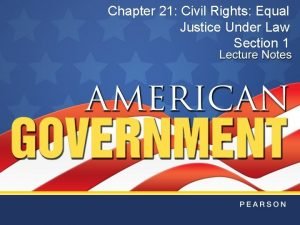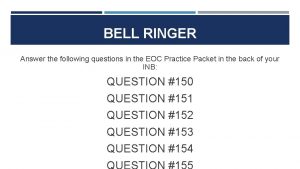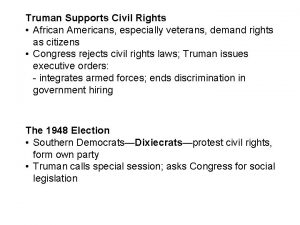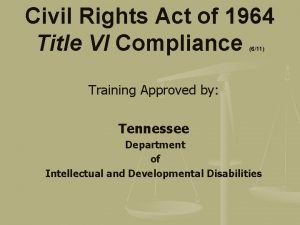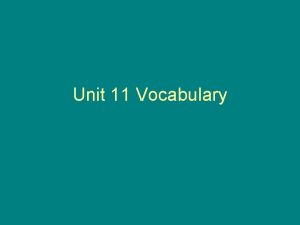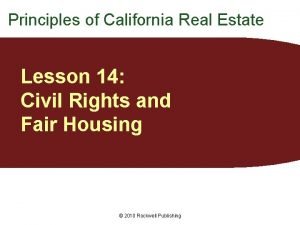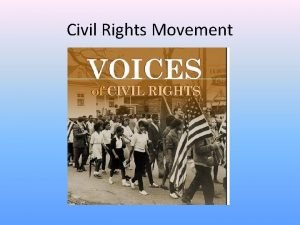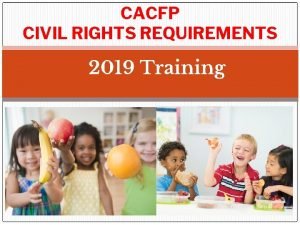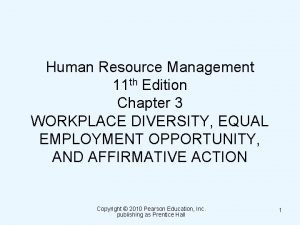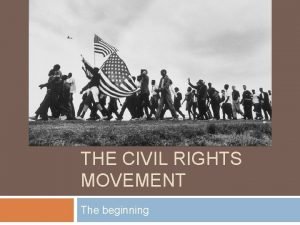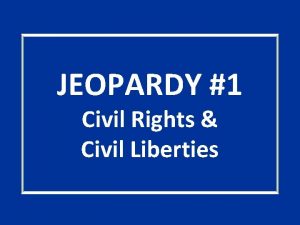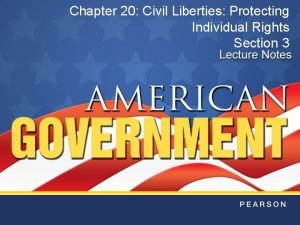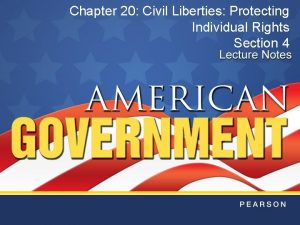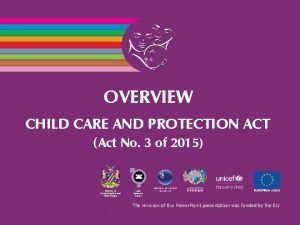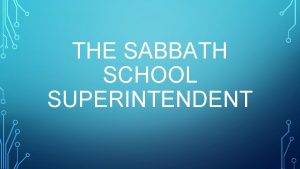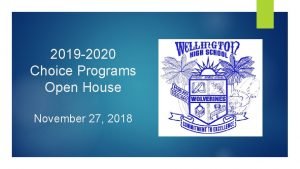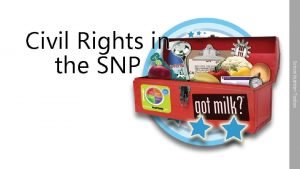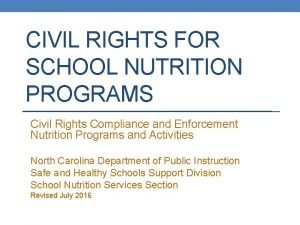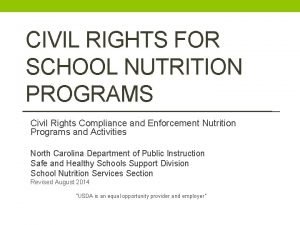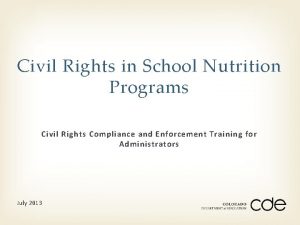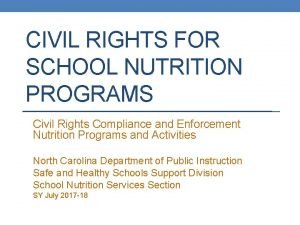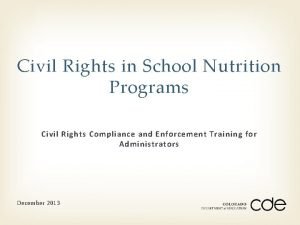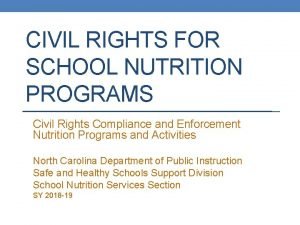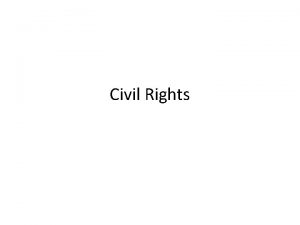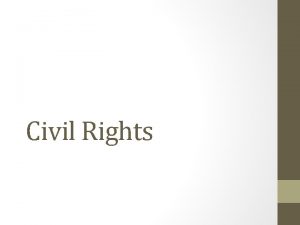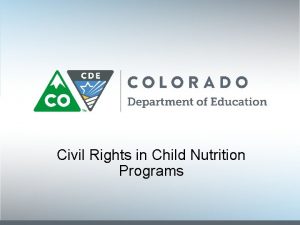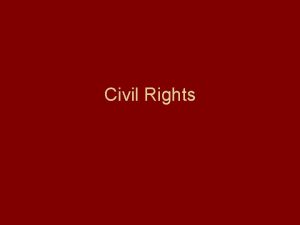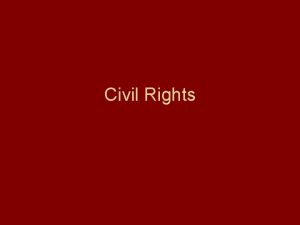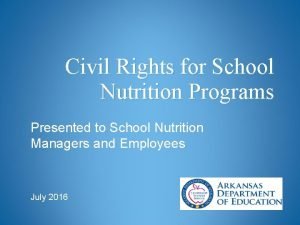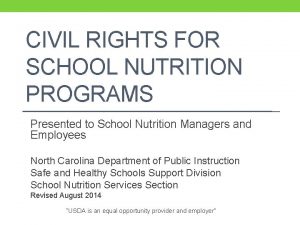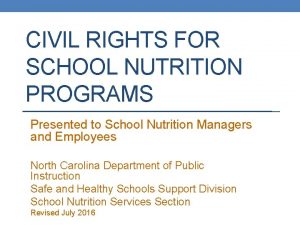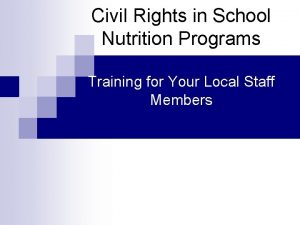Civil Rights in School Nutrition Programs Purpose and
























































- Slides: 56

Civil Rights in School Nutrition Programs

Purpose and Authority § Purpose – Ensures compliance with and enforcement of the prohibition against discrimination in all nutrition programs 2

Civil Rights Compliance and Enforcement § USDA 7 CFR parts 210, 215, 220, 225 and 226 § FNS 113 -1 3

USDA (Federal) Protected Classes for School Nutrition Programs § Race § Color § National origin § Age § Sex § Disability § Gender identity § Religion § Political beliefs § Marital status § Familial or parental status § Sexual orientation 4

Civil Rights Requirements for School Food Authorities (SFAs) 1. Provide public notification. 2. Provide reasonable accommodations for: – limited English persons, and – those with disabilities. 3. Handle civil rights complaints according to prescribed procedures. 4. Conduct annual civil rights training. 5. Conduct compliance reviews as applicable. 5

Purpose of Civil Rights Training § To inform, educate, and support all staff who interact with school meal program applicants on: – staff rights and responsibilities as administrators of school meal programs, – general USDA civil rights requirements, and – resources and information available to assist staff in carrying out their civil rights responsibilities. § Local educational agencies (LEAs) are responsible for annually training their front line staff and supervisors who interact with applicants or participants. § Training must be documented. 6

Document all civil rights trainings. 7

Civil Rights Training Matrix USDA State Agency Local Agencies Frontline Staff 8

Civil Rights Training § Specific subject matter required to be included in training, but not limited to: – – – collection and use of data, effective public notification systems, complaint procedures, compliance review techniques, resolution of noncompliance, requirements for reasonable accommodation of persons with disabilities, – requirements for language assistance, – conflict resolution, and – customer service. 9

Public Release § Inform applicants, potentially eligible persons, participants, and grassroots organizations of program or changes in the program. – Includes information pertaining to: • • • eligibility, benefits, services, location of local facilities or service delivery points, and hours of service. 10

Public Release (Cont’d. ) § Communicate using methods such as: – – – internet and computer-based applications, newspapers, radio/television, letters/leaflets/brochures, and bulletins. 11

Public Release (Cont’d. ) § The department’s website has the public release information for SFAs. The link to the site is: http: //www. tn. gov/education/topic/school-nutrition. 12

Public Notification § All informational materials and sources used to inform the public about school nutrition programs must use the USDA nondiscrimination statement, which includes: – all materials for public information, education, or distribution (handbooks, letters); and – websites. § Not required on items such as pens or buttons, which identify the program when size makes it impractical. 13

Required Nondiscrimination Statement Language In accordance with Federal civil rights law and U. S. Department of Agriculture (USDA) civil rights regulations and policies, the USDA, its Agencies, offices, and employees, and institutions participating in or administering USDA programs are prohibited from discriminating based on race, color, national origin, sex, disability, age, or reprisal or retaliation for prior civil rights activity in any program or activity conducted or funded by USDA. Persons with disabilities who require alternative means of communication for program information (e. g. Braille, large print, audiotape, American Sign Language, etc. ), should contact the Agency (State or local) where they applied for benefits. Individuals who are deaf, hard of hearing or have speech disabilities may contact USDA through the Federal Relay Service at (800) 877 -8339. Additionally, program information may be made available in languages other than English. To file a program complaint of discrimination, complete the USDA Program Discrimination Complaint Form, (AD-3027) found online at: http: //www. ascr. usda. gov/complaint_filing_cust. html, and at any USDA office, or write a letter addressed to USDA and provide in the letter all of the information requested in the form. To request a copy of the complaint form, call (866) 632 -9992. Submit your completed form or letter to USDA by: (1) mail: U. S. Department of Agriculture Office of the Assistant Secretary for Civil Rights 1400 Independence Avenue, SW Washington, D. C. 20250 -9410; (2) fax: (202) 690 -7442; or (3) email: program. intake@usda. gov. This institution is an equal opportunity provider. 14

Public Notification § If the material is too small to permit the full statement to be included, the material will, at a minimum, include, “This institution is an equal opportunity provider. ” – Also allowed for internet, radio, and TV public service announcements § Print size for the short statement shall be no smaller than the text in the material. 15

“And Justice For All” Posters § All agencies participating in school nutrition programs must display the USDA’s nondiscrimination poster in a prominent area where participants and potential participants have access. – Examples: cafeteria/food service area, school nutrition office – Must be posted at every food service/preparation site § Must be 11” x 17” format. 16

Poster Source § "And Justice For All" poster is available to download from the USDA website at http: //www. fns. usda. gov/cr/justice. htm. 17

Public Notification (Cont’d. ) § Methods of public notification: – Prominently display the “And Justice For All” poster or a Food and Nutrition Service (FNS)-approved substitute – Provide appropriate information in alternative formats for persons with disabilities – Convey the message of equal opportunity in all photos and other graphics that are used to provide program or program-related information 18

Public Notification for Alternate Service Locations § If children are receiving lunch in the cafeteria where the poster is prominently posted, a poster is not required in all of the various locations in the school where breakfast may be served. § In those situations where all meals may be delivered to an alternate location, a poster would be required. 19

Collecting and Reporting Participant Data § Why do I have to collect racial and ethnic data? – Racial/ethnic data is used to determine how effectively your program is reaching potentially eligible children and to see where outreach may be needed. 20

Collecting and Reporting Participant Data (Cont’d. ) § Establish a system to collect racial and ethnic data. § Data must be reported on an annual basis. § Program applicants may not be required to furnish ethnicity and race. – You may inform the household, however, that collection of this information is strictly for statistical reporting and has no influence on eligibility determination for the program. § Data collectors may not second guess, change, or challenge a self-declaration of ethnicity/race made by a participant unless such declarations are blatantly false. 21

How do we obtain the data? § Voluntary self-identification or self-reporting (preferred method). ‒ Free/reduced (F/R) meal application: Household applications that are completed each year and submitted to the SFA site have a section for the household to identify their racial and ethnic data (households are not required to complete this). § If a household chooses not to provide racial/ethnic information, you may use one of the following two methods: – visual identification by an SFA site official; or – personal knowledge, records, or other documentation your agency possesses that identify household racial/ethnic data. 22

Collecting and Reporting Participant Data (Cont’d. ) § Two-question format must be used for ethnic and racial categories: – Ethnicity is to be asked first: • Hispanic or Latino • Not Hispanic or Latino § Race (instructions should specify, “mark one or more”): – – – American Indian or Alaskan Native Asian Black or African American Native Hawaiian or Other Pacific Islander White 23

Managing the Data That is Collected § Collection systems must ensure that data collected/retained are: – collected and retained by each program site; – based on documented records; – maintained under safeguards that restrict access to personal records to only authorized personnel (i. e. , data should be kept secure and confidential); – submitted, if requested, to the USDA FNS regional or headquarters offices; – kept on file for three years plus the current year, and; – identifying all sources of information used. 24

Compliance Reviews § The purpose of the review is to determine if the applicant or recipient of federal financial assistance is in compliance with the USDA civil rights requirements. 25

Compliance Reviews (Cont’d. ) § Reviewer will ask: – Have you ever received any written or verbal complaints alleging discrimination? – If yes, have these complaints been reported to the SA? – What is your policy to handle a complaint of discrimination? 26

Compliance Reviews (Cont’d. ) § No separation based on race, color, sex, handicap, age, or national origin in: – – eating periods, seating arrangements, serving lines, and eating areas. 27

Compliance Reviews (Cont’d. ) § Public release – Letter to parents, application form, income guidelines – Copy on file § Foreign language translations are available § USDA poster displayed in prominent place § Correct nondiscrimination statement on program materials § Admission procedures do not restrict enrollment by minority persons § Incorrectly denied F/R applications are not disproportionately composed of minority applications § Disabled students are provided program benefits 28

Compliance Reviews (Cont’d. ) § Civil rights findings during the administrative review require a corrective action plan that ensures compliance. 29

Resolution of Noncompliance § Noncompliance: a factual finding that any civil rights requirement, as provided by law, regulation, policy, instruction, or guidelines is not being adhered to. § There are no “minor” or “major” categories of noncompliance. All instances of noncompliance are considered equally. – No matter the level or severity of noncompliance, it must be reported. 30

Resolution of Noncompliance § If noncompliance is indicated, a corrective action plan must be implemented immediately to achieve voluntary compliance within 60 days. § Corrective action plan: plan describing the SFA’s actions to be taken to resolve noncompliance with civil rights requirements. 31

Examples of Noncompliance § Denying an individual or household the opportunity to apply for school meal programs benefits or services on the basis of federally protected classes (race, color, national origin, age, etc. ) § Providing school meal programs services or benefits in a dissimilar manner on the basis of race, color, national origin, age, or sex. – Example: serving lunch to an African American child but serving a snack/modified meal to an Asian American child § Selecting school meal programs sites or facilities in a manner that denies an individual access to program benefits, assistance, or services on the basis of federally protected classes (race, color, national origin, etc. ) – Example: serving breakfast in some SFA sites, but not at SFA sites located in areas with a high proportion of children with disabilities or a high proportion of minority students 32

Civil Rights Coordination Within Your SFA § SFAs and/or your local board should designate an employee who is responsible for USDA civil rights issues: – This individual must be designated to receive complaints. – This individual should be identified to all employees. – The designated person should know who to contact if civil rights issues arise. 33

Complaint Procedures § Recognizing a civil rights complaint: – Allegation may be based on race, color, national origin, age, disability, sex, gender identity, religion, reprisal, and where applicable, political beliefs, marital status, familial or parental status, sexual orientation. Allegation may also be based on if all or part of an individual's income is derived from any public assistance program, or protected genetic information in employment or in any program or activity conducted or funded by the department. 34

Complaint Procedures (Cont’d. ) § Complaint must be filed within 180 days (timeframes must be adhered to). § Complaints may be written or verbal, as well as anonymous. – Make an effort to obtain: • name, address, and phone number of complainant, and location and name of the LEA delivering the service; • nature of the incident or action; and • basis on which the complainant believes discrimination exists (which protected class). 35

Complaint Procedures (Cont’d. ) § Names, phone numbers, titles, and business or personal addresses of persons who may have knowledge of the action § Date during which the alleged actions occurred or duration of occurrences § All complaints must be kept confidential and the resolution of complaints is always encouraged at the lowest possible level § To file a complaint with the department, you may contact Christy Ballard, Staff Attorney, via phone: (615) 741 -2921; fax: (615) 532 -4791; or email: Christy. Ballard@tn. gov. 36

Conflict Resolution In no way is an SFA to impede with a customer’s right to file a civil rights complaint. However, most conflicts are easily resolved by using appropriate tools. Conflict resolution consists of very useful tools to assist with the solution of complaints. The Conflict Resolution Network, found online at www. crnhq. org, identifies skills used in successful conflict resolution. 1. Using a win/win approach is about changing the conflict from an adversarial attack and defense, to cooperation. It is this powerful shift of attitude that alters the course of communication. 2. Using a creative response is about turning problems into possibilities. It is about consciously choosing to see what can be done, rather than focusing on the perceived problem. It is affirming that you will choose to extract the best from the situation. 3. Demonstrating empathy is about rapport and openness between people. When it is absent, people are less likely to consider needs and feelings. The best way to build empathy is to help the others feel that they are understood. That means being an active listener. 4. When employing appropriate assertiveness you should be able to state your case without arousing the defenses of the other person. The secret of success lies in saying how it is for you rather than what they should or shouldn't do. “The way I see it. . . " attached to your assertive statement, helps. A skilled "I" statement goes even further. 37

Conflict Resolution (Cont’d. ) 5. Cooperative power is being faced with a statement that has potential to create conflict, then asking open-ended questions to reframe resistance. Explore the difficulties and then re-direct discussion to focus on positive possibilities. 6. Remember that managing emotions is internal as well as external. It is vital to manage your own emotions, sticking strictly to the facts of the complaint, and not invoking negative emotional reactions from the complainant. The secret is to start by supporting their real needs without supporting their destructive beliefs, and alienating patterns of reaction. 7. A willingness to resolve the conflict is essential by both parties. Assessing each person’s willingness to resolve, identifying barriers to a resolution, and overcoming the barriers will continue the resolution process. 38

Conflict Resolution (Cont’d. ) § The USDA recommends using an Alternative Dispute Resolution (ADR) program. – ADR definition: use of a neutral third party (usually a person acting as a facilitator) to informally resolve a complaint of discrimination through use of various techniques such as fact finding, mediation, peer panels, facilitation, ombudsman support, or conciliation. 39

Requirements For Language Assistance § Limited English Proficiency (LEP) is defined as individuals who do not speak English as their primary language and who have a limited ability to read, speak, write, or understand English. § Reasonable steps must be taken to ensure meaningful access to the information and services provided for persons with limited English proficiency. 40

Requirements For Language Assistance (Cont’d. ) § Reasonable steps are contingent on: – number or proportion of LEP persons served or encountered in the eligible population; – frequency with which LEP individuals come in contact with the program; – nature and importance of the program, activity, or service provided by the program; – resources available to the recipient; and – costs. 41

Requirements For Language Assistance (Cont’d. ) § Resource factors to consider in serving LEP: – accessibility of a translator, and – availability of materials in various languages. • Language line phone service may be available for a subscription fee through your local telephone service provider. • Translated applications are on the USDA website. 42

Requirements For Language Assistance (Cont’d. ) § The department and school districts must make materials available in the appropriate language. § Application translations can be found at http: //www. fns. usda. gov/school-meals/familyfriendly-application-translations. 43

Customer Service § All students must be allowed equal opportunities to participate in school nutrition programs regardless of race, color, national origin, sex, age, disability, or other state-protected classes. § All participants must be treated in the same manner (e. g. , seating arrangements, serving lines, services and facilities, assignment of eating periods, methods of selection for application approval, and verification processes). 44

Customer Service (Cont’d. ) § All participants must be treated in the same manner: – Each person receives the same menu items in the same amounts. – All persons are included in meals, snacks, activities, and discussions. – Each person receives positive comments, as well as constructive education regarding meal time, nutrition, manners, etc. – Standards of behavior are not based on membership in a protected class. 45

Customer Service (Cont’d. ) § Children must not be required to use a separate dining room, separate serving line, or separate serving time based on eligibility for F/R meals, sex, national origin, race/color, etc. – Examples: • Students of about the same age are given about the same time to eat. • Students whose first language is Spanish are not required to sit at a “Spanish-speaking” table for meals. • Boys are not seated at separate tables from girls (this is implied segregation and questionable unless done for disciplinary or legitimate reasons). 46

Customer Service (Cont’d. ) § All students within the same grade grouping must be offered the same selection of menu items in the same amounts regardless of their eligibility, sex, national origin, race/color, etc. , including when a school offers: – a selection of more than one type of meal that is claimed for reimbursement, and – a variety of foods and fluid milk for choice within the meal requirements. § Examples: – Boys and girls in the same grade are offered the same food, in the same amounts. – Leftovers at the end of the lunch period are offered to everyone (i. e. , not just the boys, etc. ) – Certain items are “saved” for all students, not just for specific students. 47

Customer Service (Cont’d. ) § USDA policy prohibits the denial of meals as a disciplinary action against any student who is enrolled in a school that participates in school nutrition programs, including: – disciplinary actions that directly result in loss or denial of meals, and – requiring a child to work for his/her meals. § The following are circumstances where meals may be denied: – Disciplinary actions that indirectly result in loss of meals (i. e. , student is suspended from school). § Schools are not required to serve children who receive reduced or full -price meals but do not have money to pay, however: – It is recommended that schools establish policies to handle such situations and inform parents/students of limitations of policy. – Each school is free to decide whether to institute negative balance limits or provide alternative meals/food items for these students. 48

What is a disability/impairment? § Definition: physical or mental impairment which substantially limits one or more of an individual’s major life activities, has a record of such an impairment, or is regarded as having such an impairment. Disabilities are defined based on section 504 of the Rehabilitation Act/Americans with Disabilities Act and Part B of Individuals with Disabilities Education Act (IDEA). – Examples: orthopedic/visual/speech/hearing impairments, cerebral palsy, epilepsy, muscular dystrophy, multiple sclerosis, cancer, specific learning disabilities, tuberculosis, diabetes, phenylketonuria, heart condition, food anaphylaxis, mental disability, emotional illness, drug addiction/alcoholism, HIV, autism, and traumatic brain injury. 49

What is the SFA site’s responsibility to children With disabilities? § Provide facilities for participants with disabilities. – Examples: accessible parking lots, entrances and exits, halls, elevators, restrooms, service animals, Braille signage, and alternative arrangements for service. § Provide appropriate information in alternative formats for persons with disabilities. – Examples: Braille program materials and sign language interpreters. § Must provide an appropriate meal when their disability or impairment restricts their food intake. 50

Providing Menu Item Substitutions § USDA regulations require substitutions or modifications in school meals for children whose disability or impairment restricts their food intake. – Example: Celiac disease; not that the parent thinks gluten-free diets are healthier. § Disabilities or impairment must be documented by a licensed healthcare professional’s statement if it changes the school meal pattern. – A child who could not be served milk would fall in this category. § The focus is not on proving that the student has a disability; rather, the focus is on what can be done to include the child. § USDA has special rules that apply to non-disability milk substitutions (see recent USDA policy memos SP 02 -2009, 35 -2009, and 07 -2010 for details). 51

Food For Thought § In order to reduce the risk of a civil rights discrimination complaint, ask yourself the following questions each time an applicant and/or participant comes to your program for services: – Am I treating this person in the same manner I treat others? – Have I informed this person of exactly what information I need to make a determination on the application? – Have I given this person the opportunity to ask questions? – Have I provided this person with the information he or she needs to make necessary decisions? 52

Questions? 53

Mission Statement Develop extraordinary school nutrition professionals and provide strategies to increase consumption of healthy school meals. 54

Districts and schools in Tennessee will exemplify excellence and equity such that all students are equipped with the knowledge and skills to successfully embark on their chosen path in life. Excellence | Optimism | Judgment | Courage | Teamwork

Nondiscrimination Statement In accordance with Federal civil rights law and U. S. Department of Agriculture (USDA) civil rights regulations and policies, the USDA, its Agencies, offices, and employees, and institutions participating in or administering USDA programs are prohibited from discriminating based on race, color, national origin, sex, disability, age, or reprisal or retaliation for prior civil rights activity in any program or activity conducted or funded by USDA. Persons with disabilities who require alternative means of communication for program information (e. g. Braille, large print, audiotape, American Sign Language, etc. ), should contact the Agency (State or local) where they applied for benefits. Individuals who are deaf, hard of hearing or have speech disabilities may contact USDA through the Federal Relay Service at (800) 877 -8339. Additionally, program information may be made available in languages other than English. To file a program complaint of discrimination, complete the USDA Program Discrimination Complaint Form, (AD-3027) found online at: http: //www. ascr. usda. gov/complaint_filing_cust. html, and at any USDA office, or write a letter addressed to USDA and provide in the letter all of the information requested in the form. To request a copy of the complaint form, call (866) 632 -9992. Submit your completed form or letter to USDA by: (1) mail: U. S. Department of Agriculture Office of the Assistant Secretary for Civil Rights 1400 Independence Avenue, SW Washington, D. C. 20250 -9410; (2) fax: (202) 690 -7442; or (3) email: program. intake@usda. gov. This institution is an equal opportunity provider. 56
 Civil rights training certificate
Civil rights training certificate Civil rights in child nutrition programs
Civil rights in child nutrition programs Civil rights in child nutrition programs
Civil rights in child nutrition programs Civil rights webquest
Civil rights webquest Cpmcd in software engineering
Cpmcd in software engineering Chapter 14 postwar prosperity and civil rights
Chapter 14 postwar prosperity and civil rights Unit 7: modern ga and civil rights
Unit 7: modern ga and civil rights Chapter 14 postwar prosperity and civil rights
Chapter 14 postwar prosperity and civil rights Food buying guide
Food buying guide Negative rights vs positive rights
Negative rights vs positive rights Characteristics of rights
Characteristics of rights Legal rights vs moral rights
Legal rights vs moral rights Negative right
Negative right Civil rights timeline of events
Civil rights timeline of events Civil rights sitins
Civil rights sitins Rosa parks mother
Rosa parks mother Define civil rights
Define civil rights Civil rights movement jeopardy
Civil rights movement jeopardy Usda civil rights training
Usda civil rights training Goals of the civil rights movement
Goals of the civil rights movement Civil rights graphic organizer
Civil rights graphic organizer Civil rights collage
Civil rights collage Civil rights choice board
Civil rights choice board Chapter 21 civil rights equal justice under law
Chapter 21 civil rights equal justice under law Chapter 20 civil liberties protecting individual rights
Chapter 20 civil liberties protecting individual rights Civil rights bell ringers
Civil rights bell ringers Truman supports civil rights
Truman supports civil rights Characteristics of civil rights
Characteristics of civil rights Civil rights cloze notes 1
Civil rights cloze notes 1 Brain wrinkles social studies answer key
Brain wrinkles social studies answer key Federally protected classes
Federally protected classes Title vi of the civil rights act of 1964
Title vi of the civil rights act of 1964 Civil rights movement vocabulary
Civil rights movement vocabulary Unruh civil rights act real estate
Unruh civil rights act real estate Civil rights movement webquest
Civil rights movement webquest Civil rights movment
Civil rights movment Cacfp civil rights
Cacfp civil rights Title vii of the civil rights act
Title vii of the civil rights act Title vii of the civil rights act
Title vii of the civil rights act The civil rights movement
The civil rights movement Civil rights jeopardy
Civil rights jeopardy Civil rights movement essential questions
Civil rights movement essential questions What did sncc accomplish and how
What did sncc accomplish and how Chapter 20 civil liberties protecting individual rights
Chapter 20 civil liberties protecting individual rights Chapter 20 civil liberties protecting individual rights
Chapter 20 civil liberties protecting individual rights Littorial rights
Littorial rights Negative rights vs positive rights
Negative rights vs positive rights Negative rights
Negative rights Negative rights vs positive rights
Negative rights vs positive rights Nutrition sport
Nutrition sport Children rights and responsibilities
Children rights and responsibilities Sabbath school program presentation ideas
Sabbath school program presentation ideas Prince william county middle school specialty programs
Prince william county middle school specialty programs Sabbath school monthly themes
Sabbath school monthly themes Role of sabbath school superintendent
Role of sabbath school superintendent Wellington high school choice programs
Wellington high school choice programs School nutrition toolbox
School nutrition toolbox
